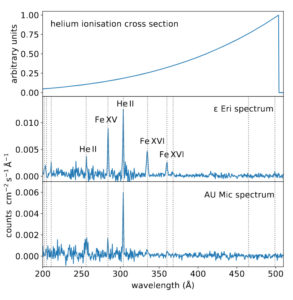Paper on helium transits of exoplanets

During the first Covid lockdown I started what I call my little pandemic project. But then all the real-life consequences of living through a worldwide pandemic set in, and it took until early this year to wrap up my project. It is finally done! And it is the first single-author paper I have ever written.
Here’s some information on the paper:
Helium absorption in exoplanet atmospheres is connected to stellar coronal abundances
Poppenhaeger, K.
Transit observations in the helium triplet around 10 830 Angstrom are a successful tool to study exoplanetary atmospheres and their mass loss. Forming those lines requires ionization and recombination of helium in the exoplanetary atmosphere. This ionization is caused by stellar photons at extreme ultraviolet (EUV) wavelengths; however, no currently active telescopes can observe this part of the stellar spectrum. The relevant part of the stellar EUV spectrum consists of individual emission lines, many of them being formed by iron at coronal temperatures. The stellar iron abundance in the corona is often observed to be depleted for high-activity low-mass stars due to the first ionization potential (FIP) effect. I show that stars with high versus low coronal iron abundances follow different scaling laws that tie together their X-ray emission and the narrow-band EUV flux that causes helium ionization. I also show that the stellar iron to oxygen abundance ratio in the corona can be measured reasonably well from X-ray CCD spectra, yielding similar results to high-resolution X-ray observations. Taking coronal iron abundance into account, the currently observed large scatter in the relationship of EUV irradiation with exoplanetary helium transit depths can be reduced, improving the target selection criteria for exoplanet transmission spectroscopy. In particular, previously puzzling non-detections of helium for Neptunic exoplanets are now in line with expectations from the revised scaling laws.
Monthly Notices of the Royal Astronomical Society, Volume 512, Issue 2, pp.1751-1764, May 2022